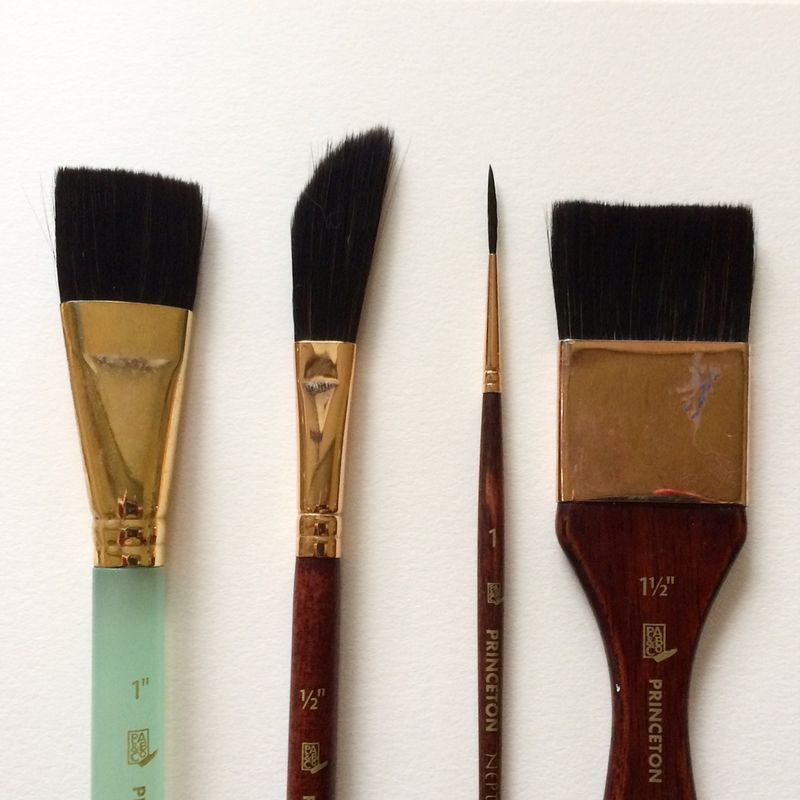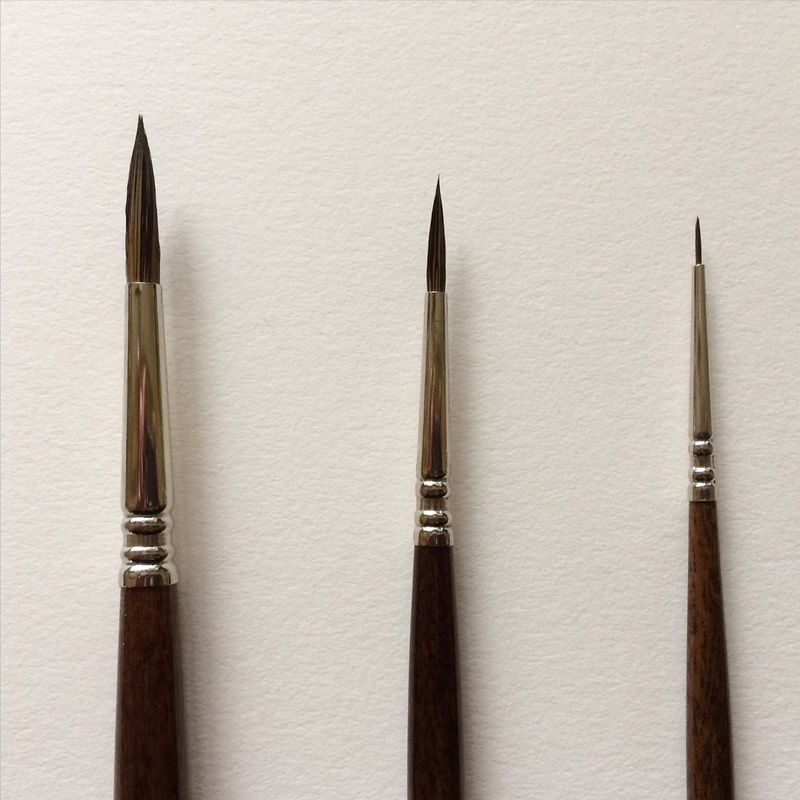
I am a believer in quality tools.
There is an old saying that goes, “It’s not the sword; it’s the skill of the knight.” This is very true, but using the wrong tools can make our job as artists much more difficult than it needs to be. I choose quality tools and materials to make my work a little easier and more enjoyable. Synthetic brushes are becoming an important part of my arsenal. As much as I love and treasure my Kolinsky sable and Russian blue squirrel watercolor brushes, there are times when I choose to use synthetics. Color mixing can be hard on a brush, so I always use an inexpensive ½” flat, synthetic brush for mixing. There are also times when the techniques or mediums for a specific painting might be a little tough on my pricey sables and squirrels. And you know, the synthetic brushes I have discovered along the way have been such great quality with fantastic results that I find myself painting with them more often than not. They sure are easy on the budget, too. However, not any synthetic brush will do the job. Fortunately, there are many wonderful options for quality synthetics that mimic and even rival sable, but don’t break the bank and are more easily replaced when they wear out.There are two things to look for when purchasing ANY watercolor brush.
1. Absorbent quality
The bristles need to be able to soak up and then easily release water. One main reason why sable and squirrel are so popular is because they soak up and hold a lot of paint, and they also slowly release it. Some synthetic bristles are too stiff and plastic, and the water and paint just don’t get soaked up. When testing a brush, dip it into a puddle of watercolor paint mixed with plenty of water and see if the brush soaks up quite a bit of paint. Then try painting on paper and see how long it takes before the paint runs out. The brush that lets you paint the longest is the brush you want to buy and use.2. Springiness
We want our brush bristles to hold their shape and be able to snap back to a point. This is one of the best qualities of a good sable brush, but there are also many brands of synthetic brushes that have this quality. To determine a brush’s springiness, dip your brush into paint and then roll it to a point. Try painting a very thin line, then using more pressure, increase the thickness of that line. When you lift the brush from the paper, it should snap back to a point. If it is still bent or splayed and you need to rewet it to get your point back…find another brush.Sable and squirrel are still best, but there are times when synthetics are suitable.
Yes, Kolinsky sable or Russian blue squirrel reign when it comes to watercolor brushes, but they are also an investment. I don’t often recommend that my beginning students start by spending a whole paycheck on a few brushes.>/p> There are also times when certain techniques are better suited for the durable synthetic brush. I most often use them when doing scrubbing, scumbling, or dry brush techniques, and when painting with inks and metallic colors>Here are a few of my favorite synthetics that make excellent brushes for any watercolorist at any level of experience.
Princeton Neptune Synthetic Squirrel
 On its website, Princeton says that they “developed a brush that may actually outperform the natural version.” Neptune is Princeton’s thirstiest brush, “delivering oceans of color” to the sheet. Even experts in natural hair have a hard time believing that the bristles are actually synthetic.
I heartily agree. I have been using the brushes pictured above for three years now and they still perform as well as when they were brand new. They absorb loads of water and pigment and have a soft, resilient springiness that always snaps right back into shape.
I use these brushes for larger washes, landscapes and backgrounds and would be lost without them. The rigger is the best rigger I have used.
On its website, Princeton says that they “developed a brush that may actually outperform the natural version.” Neptune is Princeton’s thirstiest brush, “delivering oceans of color” to the sheet. Even experts in natural hair have a hard time believing that the bristles are actually synthetic.
I heartily agree. I have been using the brushes pictured above for three years now and they still perform as well as when they were brand new. They absorb loads of water and pigment and have a soft, resilient springiness that always snaps right back into shape.
I use these brushes for larger washes, landscapes and backgrounds and would be lost without them. The rigger is the best rigger I have used.
Escoda Versàtil
 The Escoda Versàtil synthetic Kolinsky brush is the modern-day alternative to natural Kolinsky. I use them mostly for small works where I need great detail and crisp lines. They are absorbent, springy and hold up to rougher handling than my pointed sables. I use sizes 6, 2 and 000. They have beautiful sharp points and are a perfect starter brush for those new to watercolor who want to paint with a lot of fine detail.
The Escoda Versàtil synthetic Kolinsky brush is the modern-day alternative to natural Kolinsky. I use them mostly for small works where I need great detail and crisp lines. They are absorbent, springy and hold up to rougher handling than my pointed sables. I use sizes 6, 2 and 000. They have beautiful sharp points and are a perfect starter brush for those new to watercolor who want to paint with a lot of fine detail.
Kolibri Squi-Line Imitation Squirrel
 These German brushes are only sold through the Natural Pigments website, and are probably my favorite watercolor brush for the value. That size 14 pointed round has made countless landscape paintings. The point is so fine it can portray the finest details. Look at that point!
I will say the ferrules do come loose after a while, but I simply glued them back on firmly. No big deal. For the price, I find these brushes incredible.
These German brushes are only sold through the Natural Pigments website, and are probably my favorite watercolor brush for the value. That size 14 pointed round has made countless landscape paintings. The point is so fine it can portray the finest details. Look at that point!
I will say the ferrules do come loose after a while, but I simply glued them back on firmly. No big deal. For the price, I find these brushes incredible.
Escoda Perla White Toray
 These are another excellent choice for detail work. Escoda Perla White Toray is one of the finest quality synthetic fibers available for artists working with watercolors. It keeps an excellent point and edge for a soft yet controlled application. For increased longevity, Escoda cures each brush to improve the spring and resilience of the hair. The short, green lacquered wood handle is triple crimped to the nickel-plated brass ferrule, so it won’t come loose even after repeated use. I am very impressed with these brushes and their ability to maintain a crisp point while holding plenty of paint.
Wonderful brushes, all.
These are another excellent choice for detail work. Escoda Perla White Toray is one of the finest quality synthetic fibers available for artists working with watercolors. It keeps an excellent point and edge for a soft yet controlled application. For increased longevity, Escoda cures each brush to improve the spring and resilience of the hair. The short, green lacquered wood handle is triple crimped to the nickel-plated brass ferrule, so it won’t come loose even after repeated use. I am very impressed with these brushes and their ability to maintain a crisp point while holding plenty of paint.
Wonderful brushes, all.

Share tips, start a discussion or ask one of our experts or other students a question.
No Responses to “How to Choose & Use Synthetic Brushes for Watercolor”